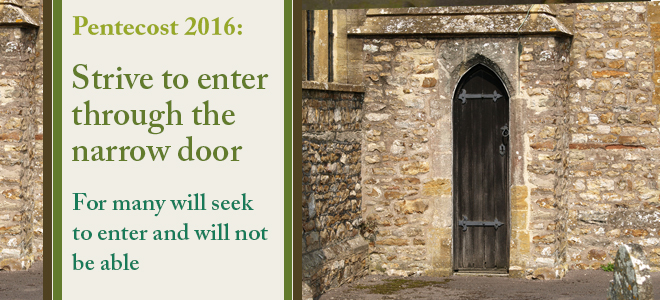 The Day of Pentecost, the Holy Spirit came upon Jesus’s Twelve Apostles in a special way, and thereby the Lord God added about 3,000 souls to His Church, as Acts chapter 2 reports (see especially v.41). As outlined in Acts 1:8, the rest of the book of Acts tells how some of the Twelve Apostles and others were witnesses to the forgiveness of sins by grace through faith in Jesus Christ in Jerusalem, in Judea and Samaria (what used to be the one nation of Israel), and to the end of the earth (at the book’s end, specifically to the capital of the Roman Empire of the day). Along the way, the Lord continued to add thousands of other believers to His Church, as Acts notes repeatedly (see Acts 2:47; 4:4; 5:14; 6:1, 7; 9:31, 35, 42; 11:21, 24; 14:1, 21; 16:5; 17:12).
The Day of Pentecost, the Holy Spirit came upon Jesus’s Twelve Apostles in a special way, and thereby the Lord God added about 3,000 souls to His Church, as Acts chapter 2 reports (see especially v.41). As outlined in Acts 1:8, the rest of the book of Acts tells how some of the Twelve Apostles and others were witnesses to the forgiveness of sins by grace through faith in Jesus Christ in Jerusalem, in Judea and Samaria (what used to be the one nation of Israel), and to the end of the earth (at the book’s end, specifically to the capital of the Roman Empire of the day). Along the way, the Lord continued to add thousands of other believers to His Church, as Acts notes repeatedly (see Acts 2:47; 4:4; 5:14; 6:1, 7; 9:31, 35, 42; 11:21, 24; 14:1, 21; 16:5; 17:12).
With such a record of numerical growth, we might reasonably though falsely expect that trend to continue after Pentecost until the end of time. The Lord Jesus teaches differently. By Divine inspiration, St. Luke records, as we will hear on the Fourteenth Sunday after Pentecost this year, someone asking Jesus whether those who are saved would be few (Luke 13:23). Oddly enough, as St. Luke records, Jesus does not answer the question directly but rather exhorts those hearing Him to strive to enter through the narrow door, for many, He says, will seek to enter and will not be able to do so (Luke 13:24). They may even have been in His presence eating and drinking once but will be cast out for eternity (Luke 13:25-30).
Of course, no one is able to enter the narrow door on his or her own, for we all are conceived sinful (Psalm 51:5), and so by nature we all are dead in our trespasses and sins (Ephesians 2:1, 5). Only by God’s mercy and grace does His Word reach us and so enable us to enter, without our sins, which are forgiven for Jesus’s sake, and without any other baggage that we might carry. Every individual so brought to repentance and faith increases the size of the Church of all times and all places, even if the number may appear to be less or even nonexistent at any one time or in any one place. We trust God so to grow His Church as He promises to do through His purely preached Word and His rightly administered Sacraments’ giving the Holy Spirit, “Who works faith, when and where He pleases, in those who hear the Gospel that we have a gracious God, not by our own merits but by the merits of Christ, when we believe this” (Augsburg Confession V:2).
The Old Testament Feast of Pentecost, fifty days after the Sabbath of Passover week (Leviticus 23:15-16), became the New Testament Feast of Pentecost, the end of the fifty days of Easter. The harvest motif carried over, however, from the first-fruits of the barley and corn harvests (Numbers 28:26) to the first-fruits of the harvest of believers into the Church. As the harvest of grains continued after Old Testament Pentecost, so does the harvest of believers continue after the New Testament Pentecost. In our Church Year, Pentecost strictly belongs to the Easter Season, but all the Sundays after Pentecost are counted in relationship to it. The Sundays after Pentecost use green paraments on the chancel furnishings and pastor’s stole, the color of growth, leaves, foliage, fruit, and life appropriate for a time of spiritual if not also numerical growth. The following are the Sundays after Pentecost in 2016 and their Gospel Readings (appointed by Lutheran Service Book’s three-year lectionary series C).
• The Holy Trinity (05/22): Jesus teaches about the glory of the Trinity (John 8:48-59)
• Second Sunday (05/29): Jesus heals a centurion’s servant (Luke 7:1-10)
• Third Sunday (06/05): Jesus raises the son of the widow of Nain (Luke 7:11-17)
• Fourth Sunday (06/12): Jesus forgives a sinful woman’s many sins (Luke 7:36-8:3)
• Fifth Sunday (06/19): Jesus casts out demons into a herd of pigs (Luke 8:26-39)
• Sixth Sunday (06/26): Jesus sets His face to Jerusalem (Luke 9:51-62)
• Seventh Sunday (07/03): Jesus sends out seventy-two others (Luke 10:1-20)
• Eighth Sunday (07/10): Jesus teaches about a good Samaritan (Luke 10:25-37)
• Ninth Sunday (07/17): Jesus is welcomed by Mary and Martha (Luke 10:38-42)
• Tenth Sunday (07/24: Jesus teaches about prayer (Luke 11:1-13)
• Eleventh Sunday (07/31): Jesus tells the Parable of the Rich Fool (Luke 12:13-21)
• Twelfth Sunday (08/07): Jesus calls us to seek His kingdom (Luke 12:22-34)
• Thirteenth Sunday (08/14): Jesus comes not for peace but division (Luke 12:49-53)
• Fourteenth Sunday (08/21): Jesus says to strive to enter the narrow door (Luke 13:22-30)
• Fifteenth Sunday (08/28): Jesus heals and teaches about banqueting (Luke 14:1-14)
• Sixteenth Sunday (09/04): Jesus tells how we will bear our own crosses (Luke 14:25-35)
• Seventeenth Sunday (09/11): Jesus teaches two “lost” parables (Luke 15:1-10)
• Eighteenth Sunday (09/18): Jesus tells a Parable of a Dishonest Manager (Luke 16:1-15)
• Nineteenth Sunday (09/25): Jesus teaches about a rich man and a beggar (Luke 16:19-31)
• Twentieth Sunday (10/02): Jesus teaches about tempting and forgiving (Luke 17:1-10)
• Twenty-first Sunday (10/09): Jesus cleanses ten lepers (Luke 17:11-19)
• Twenty-second Sunday (10/16): Jesus tells of a Persistent Widow (Luke 18:1-8)
• Twenty-third Sunday (10/23): Jesus teaches of worship and justification (Luke 18:9-17)
• Twenty-fourth Sunday (10/30): Jesus seeks and saves the lost (Luke 19:1-10)
• All Saints’ Day (observed 11/06): Jesus describes the blessed saints (Matthew 5:1-12)
• Twenty- sixth Sunday (11/13): Jesus gives signs of the end (Luke 21:5-36)
• Last Sunday of the Church Year (11:20): Jesus warns of the last days (Luke 23:27-43)
You may have noticed that, instead of ordinary Sundays after Pentecost, on two dates in 2016 we have special Sunday observances. The First Sunday after Pentecost is observed as the Feast of the Holy Trinity, which celebrates not the teaching about God but our God Himself, Who actually is three Blessed Persons in one Divine Substance. (This Sunday observance includes the singing of much-loved hymns and what turns out to be our annual use of the Athanasian Creed, which confesses the mystery of the Trinity about as clearly and concisely as we might imagine is possible.) And, instead of observing the 25th Sunday after Pentecost, we transfer our observance of All Saints’ Day to November 6th (at which service the Gospel Reading will be Matthew 5:11-12).
In addition to the Sundays after Pentecost and other Sunday observances listed above, the season after Pentecost in 2016 includes two midweek observances. We observe Reformation Day on Monday, October 31, with a special joint Vespers service at 7:00 p.m. (at which service the Gospel Reading will be either John 8:31-36 or Matthew 11:12-19), and we observe a Day of Thanksgiving on its Eve, Wednesday, November 23 at 7:00 p.m. (at which service the Gospel Reading again will be Luke 17:11-19).
You may read and hear the sermons at Pilgrim from the Sundays after Pentecost and from every season of the Church Year here.
The banner graphic at the top of this page and in the slider on the front page was composed by Carla Adsit, quoting from Luke 13:24 and using Mickywin Photography’s April 22, 2008, picture of the side door apparently into the Church of St. Mary in West Buckland, Somerset, England, found here.

